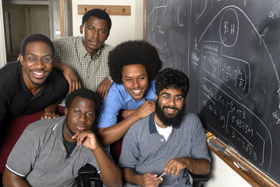
The exotic cosmic phenomenon called "gravitational lensing" will be the topic of scientific posters presented by five students at a June 21-24, 2005, scientific conference in Los Angeles.
Gravitational lensing is the bending of light passing by massive objects, such as black holes and stars, as that light streams millions of light years to earth. Astrophysicists use the lensing phenomenon to infer the position and composition of such celestial objects.
The five students -- Peter Blair, Ibraheem Mohammed, Luke Stewart, Alberto Teguia and Gabriel Williams -- will each present their poster on a different aspect of gravitational lensing at the Conference for African American Researchers in the Mathematical Sciences (CAARMS) at the University of California, Los Angeles.
In their papers, the students will present mathematical models to explain specific cases of gravitational lensing. These models rely on theories of relativity that Albert Einstein began setting out almost exactly a century ago -- for example his prediction that massive objects will cause space around them to warp so that light moving past them would travel along a curved trajectory.
In his poster, Williams will present a model of light from a distant source traveling around a cluster of stars to earth.
"One of the great things about studying light is light can only travel so fast," said Williams, a rising junior at MorehouseCollege. "So, if you track light that came from millions of light years away, then you're really looking at the distant past." Williams, a mathematics and physics major, is doing research at Duke this summer as part of the mathematics department's Practical Research for Undergraduates with VIGRE (PRUV) program.
"To me what's really fascinating is the big picture," said Blair, a rising Duke senior and double major in mathematics and physics. "The big picture is so captivating because just looking out into space and you're, like, 'Wow, these things are so far, they're so huge,' and we have a tool where we can begin to explore them."
Blair's poster predicts how light curves around black holes, which consist of matter collapsed down to such density that their gravitational effect on the space surrounding them is infinitely strong.
Stewart's poster examines the effect of "dark matter" on the trajectory of cosmic light. Dark matter is an invisible substance believed to be spread across the universe.
A current puzzle for astrophysics is the distribution of this mysterious dark matter, explained Stewart, a rising junior and mathematics major. "By analyzing the bending angle and magnification of the light source, then you're able to predict whether [the intervening dark matter] is smooth or clumped up," he said.
Mohammed, a rising junior and mathematics major, is examining a special case of light traveling past a galaxy: when a single source of light is distorted by intervening galactic matter so as to produce multiple images of the source when viewed from earth.
Mohammed, a PRUV fellow, said he was already intrigued by astrophysics from reading popular science articles, but through his research project has come to appreciate the elegance of Einstein's mathematics.
Teguia just arrived at Duke this summer as a first-year graduate student in mathematics and so will not present the research he is just beginning on gravitational lensing. Instead, he will give a poster based on his master's thesis, on mathematics used in modeling the brain.
"I'm interested by anything new I see," said Teguia, about exploring a new area of research. "My first exposure to this topic was in high school; I had a book about Einstein Relativity Theory, but I didn't have enough knowledge to understand it all but it stayed in the back of mind."
The CAARMS conference aims to highlight the work of black researchers and encourage under-represented minorities to enter mathematics-intensive scientific fields.
The students said they see the conference as a chance to network, to show off their work and to learn from leading researchers. However, they also appreciate its goal of supporting them in fields in which few African Americans work.
"Of course it's something you want to be aware of," said Blair who grew up in the Bahamas before moving with his family to Chicago. "But it's not something you want to focus on and allow that to limit you because what is the passion is the science."
"I wish we didn't need minority conferences," said Teguia, who is from Douala, Cameron. "But as you know, it's a fact we still have some racial discrimination."
"It remains important above all things that we are excellent at what we do regardless of our race," said Williams, an Atlanta, Ga., native.
The students' research this summer is funded by a National Science Foundation grant to their advisor Professor Arlie Petters. Blair, Stewart and Williams also receive financial support from Mellon Mays Undergraduate Fellowships. Stewart is a Reginaldo Howard Scholar.